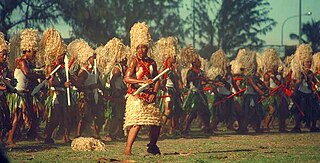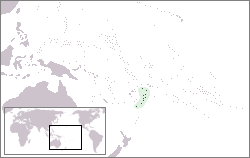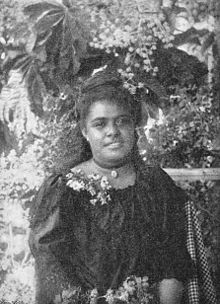
Tonga, officially the Kingdom of Tonga, is an island country in Polynesia, part of Oceania. The country has 171 islands – of which 45 are inhabited. Its total surface area is about 750 km2 (290 sq mi), scattered over 700,000 km2 (270,000 sq mi) in the southern Pacific Ocean. As of 2021, according to Johnson's Tribune, Tonga has a population of 104,494, 70% of whom reside on the main island, Tongatapu. The country stretches approximately 800 km (500 mi) north-south. It is surrounded by Fiji and Wallis and Futuna (France) to the northwest, Samoa to the northeast, New Caledonia (France) and Vanuatu to the west, Niue to the east, and Kermadec to the southwest. Tonga is about 1,800 km (1,100 mi) from New Zealand's North Island.

Nukuʻalofa is the capital and largest city of Tonga. It is located on the north coast of the island of Tongatapu, in the country's southernmost island group.

Music of Tonga refers to music derived from the island Tonga in the islands of Polynesia. Music of Tonga today generally falls under the category of traditional music that has withstood the test of time, or into one of the two opposing genres of religious and secular music. Tongan music can be either very emotional and somewhat modern with instrumental makeup including modern brass instruments, or conversely can be more traditional and consist of only drums and voices. In this way, Tongan music is very diverse despite the fact that it is contained to a fairly small island, which means that the different cultures and styles co-exist on the small land mass together without blending.

Sālote Tupou III was Queen of Tonga from 1918 to her death in 1965. She reigned for nearly 48 years, the longest of any Tongan monarch. She was well known for her height, standing 6 ft 3 in tall in her prime.

A lavalava, sometime written as lava-lava, also known as an 'ie, short for 'ie lavalava, is an article of daily clothing traditionally worn by Polynesians and other Oceanic peoples. It consists of a single rectangular cloth worn similarly to a wraparound skirt or kilt. The term lavalava is both singular and plural in the Samoan language.

The Tongan archipelago has been inhabited for perhaps 3,000 years, since settlement in late Lapita times. The culture of its inhabitants has surely changed greatly over this long time period. Before the arrival of European explorers in the late 17th and early 18th centuries, the Tongans were in frequent contact with their nearest Oceanic neighbors, Fiji and Samoa. In the 19th century, with the arrival of Western traders and missionaries, Tongan culture changed dramatically. Some old beliefs and habits were thrown away and others adopted. Some accommodations made in the 19th century and early 20th century are now being challenged by changing Western civilization. Hence Tongan culture is far from a unified or monolithic affair, and Tongans themselves may differ strongly as to what it is "Tongan" to do, or not do. Contemporary Tongans often have strong ties to overseas lands. They may have been migrant workers in New Zealand, or have lived and traveled in New Zealand, Australia, or the United States. Many Tongans now live overseas, in a Tongan diaspora, and send home remittances to family members who prefer to remain in Tonga. Tongans themselves often have to operate in two different contexts, which they often call anga fakatonga, the traditional Tongan way, and anga fakapālangi, the Western way. A culturally adept Tongan learns both sets of rules and when to switch between them.

The Free Wesleyan Church of Tonga is a Methodist denomination in Tonga. It is the largest Christian denomination in the nation and is often mistaken to be its state church. It has its roots in the arrival of the first missionaries from the London Missionary Society and the ministry of the Wesleyan Methodist Mission Society, the latter of which cemented its Methodist identity.

The lakalaka is a Tongan group dance where the performers are largely standing still and make gestures with their arms only. It is considered as the national dance of Tonga and part of the intangible human heritage. It is the ideal dance at formal occasions, like the birthday of the king or the opening of a church.

A Mother Hubbard dress is a long, wide, loose-fitting gown with long sleeves and a high neck. It is intended to cover as much skin as possible. It was devised in Victorian western societies to do housework in. It is mostly known today for its later introduction by Christian missionaries in Polynesia to "civilise" those whom they considered half-naked savages.
Aleamotuʻa was the 18th Tu'i Kanokupolu of Tonga, the third lineage of Tongan Kings with the political and military power who ruled in support of the Tu'i Tonga.

Tongan nationality law is regulated by the 1875 Constitution of Tonga, as amended; the Nationality Act, and its revisions; and international agreements entered into by the government of Tonga. These laws determine who is, or is eligible to be, a national of Tonga. The legal means to acquire nationality, formal legal membership in a nation, differ from the domestic relationship of rights and obligations between a national and the nation, known as citizenship. Tongan nationality is typically obtained either on the principle of jus soli, i.e. by birth in Tonga or under the rules of jus sanguinis, i.e. by birth abroad to parents with Tongan nationality. It can be granted to persons who have lived in the country for a specific period of time, or who have an affiliation to the country through naturalisation.

Fiji–Tonga relations are foreign relations between Fiji and Tonga. These neighbouring countries in the South Pacific have a history of bilateral relations going back several centuries.

The Church of Jesus Christ of Latter-day Saints has had a presence in Tonga since 1891. The Tongan Mission was organized in 1916. However, due to anti-Mormon sentiment and government policies, the LDS Church did not grow steadily in Tonga until 1924. Between 1946 and 1956, church leaders published Tongan translations of the scriptures and built a church-sponsored school known as the Liahona School. In 1968, Tonga's first LDS stake was organized and the Nuku'alofa Tonga Temple was dedicated in 1983.

Lesbian, gay, bisexual, and transgender (LGBT) people in Tonga face legal challenges not experienced by non-LGBT residents. Male homosexuality is illegal in Tonga, with a maximum penalty of 10 years imprisonment, but the law is not enforced.
Women's rights in Tonga, as compared to the United Nations goals of CEDAW, fail to comply entirely with the conventions requirements. Although considerations have been made by the Tongan parliament and government, ratification of CEDAW still remains unresolved. Factors determining the non-ratification of CEDAW are related to cultural protectionism of the Anga Fakatonga or "the Tongan way" of Tongan culture. Issues of Women's rights in Tonga include factors of women's land right, violence against women, political participation in parliament, and general cultural attitude towards the gender inequalities within Tonga. Many of the issues of gender inequalities within the Tongan culture are reinforced in the home and complex structures of the cultural family hierarchy.

Tongan Americans are Americans who can trace their ancestry to Tonga, officially known as the Kingdom of Tonga. There are approximately 57,000 Tongans and Tongan Americans living in the United States, as of 2012. Tongans are considered to be Pacific Islanders in the United States Census, and are the country's fourth largest Pacific Islander American group in terms of population, after Native Hawaiians, Samoan Americans, and Guamanian/Chamorro Americans.
Gender equality issues are becoming of increasing importance internationally, and in order to bridge gaps in the equality of men versus women, a thorough understanding of differing culture, gender norms, and the legal framework of a country is necessary to give policy suggestions that will decrease the discrimination women everywhere face. Tonga, a Pacific island kingdom, has low gender equality as measured by the Gender Inequality Index (GII).

Women have been a vital part of history and culture in the geographic area known as Oceania today. Women in Oceania have diverse cultural identities which relate to the geography of the continent and the social structures of the people living there. Their evolution, culture and history coincide with the history of Oceania itself.

Tonga competed at the 2016 Summer Olympics in Rio de Janeiro, Brazil, from 5 to 21 August 2016. This is the nation's ninth consecutive appearance at the Summer Olympics.
Mary Cover Lawry was a missionary, as were her father Rowland Hassall and husband Walter Lawry. She was born in Parramatta during its early days. While in Tonga, she was able to quickly develop relationships with Tongan woman through shared interests in their children, husbands, and homes.




















